Alderlea & Glen May Villa, Raikes Parade, Blackpool
Two buildings with a link to
cricket history.
Both built by the Victorian cricketer, Richard Gorton Barlow.
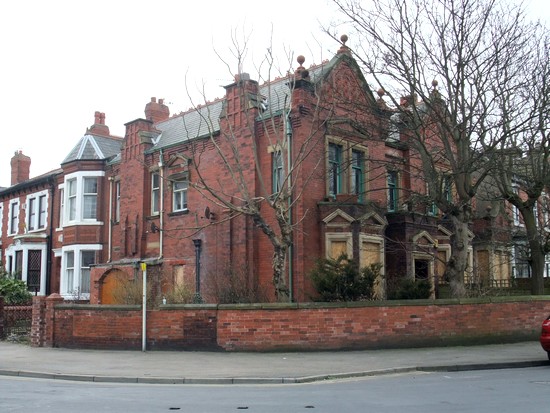
|
|
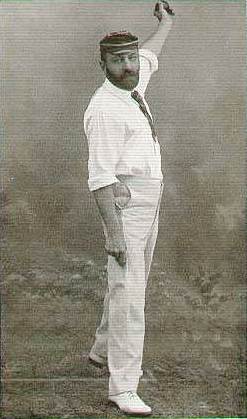 Barlow is
immortalised in one of the best-known pieces of cricket poetry, a poem called "At
Lord's" by Francis Thompson which is attached to The Ashes
urn: Barlow is
immortalised in one of the best-known pieces of cricket poetry, a poem called "At
Lord's" by Francis Thompson which is attached to The Ashes
urn:
It is little I repair to the matches of the Southron folk,
Though my own red roses there may blow;
It is little I repair to the matches of the Southron folk,
Though the red roses crest the caps, I know.
For the field is full of shades as I near a shadowy coast,
And a ghostly batsman plays to the bowling of a ghost,
And I look through my tears on a soundless-clapping host
As the run stealers flicker to and fro,
To and fro:
O my Hornby and my Barlow long ago !
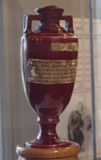
LINKS - these open in a new window
Richard Gorton Barlow on
Wikipedia
An article about Richard Gorton Barlow
Barlow, Richard Gorton by Don
Ambrose
|
Alderlea (Gorton Villa) 1891-1895
|
|
In 1891, R.G.Barlow was living at Gorton House, Stretford Road, Manchester, with
his wife, Harriet, and daughter, Alice. His father, Richard Barlow (1826-1903), was living at
30, Buchanan Street, Blackpool (1891 Census).
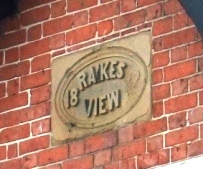 The Blackpool Herald, 26 June 1891. The Blackpool Herald, 26 June 1891.
The "Spy" last week states, in an article on Mr. R. G. Barlow,
the veteran Lancashire cricket professional, that gentleman's house near
Raikes Hall, when completed, will probably be exceedingly unique, and
will be known far and near for its artistic cricket design.
|
|
Newspaper article from the Blackpool Herald, December 2nd, 1892.
R.G. BARLOW'S
HOME
|
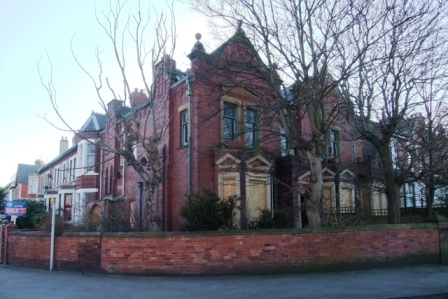
Alderlea, Raikes Parade, Blackpool,
2010, with Glen May Villa to the
left. Alderlea was built by Richard Gorton Barlow (1851-1919) in
1891. The house was originally named "Gorton Villa" and it cost £1,500 to
construct. At this time the address was no.4, Raikes View and it faced the entrance
to Raikes Hall Gardens.
|
My journalistic
curiosity was this week whetted by a paragraph appearing in one of Mr. Newnes' popular
periodicals anent Mr. R. G Barlow's new residence at Blackpool, and I accordingly resolved to
pay the famous cricketer a visit. I called upon him one morning, and was most courteously
received. He has styled his
house "Gorton villa,'' after his own name.
It stands at the corner of Raikes-parade, to the right of Raikes Hall Gardens,
and he says it is quite good enough for a professional cricketer. Go in whatever part of the
house you will, there is something to remind you of the great summer game. All around there is
nothing but cricket curiosities. With pardonable pride and evident affection, Mr. Barlow showed
many of them to me, and told me a little of their history.
|
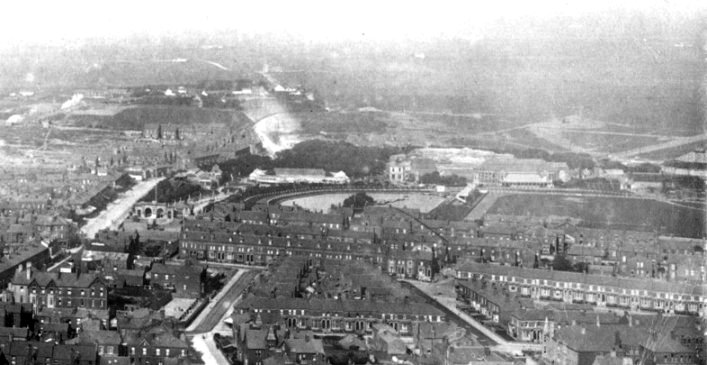
A photograph looking inland from Blackpool Tower c1894. To
the left is Church Street with the Stanley Arms, Grosvenor Hotel & St.John's
School. A little further along are arches (see below) which formed the entrance to
Raikes Hall Gardens. Houses along Raikes Parade overlooked the Gardens.
|
|
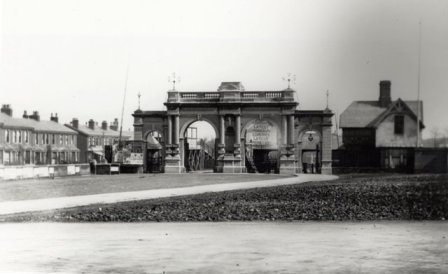
Raikes Hall Gardens Entrance
c1899. When the house was built
it stood facing the entrance gates to Raikes Hall Gardens. In this photo, Church
Street is to the left and the four houses on Raikes View are off the photo to the
right.
The gardens
closed in 1901 and they are now the site of Lincoln, Longton, Leicester, Liverpool
& Leeds Roads; Raikes Hall is now a public house and the Salvation
Army Citadel stands on the site of the
gates.
|
|
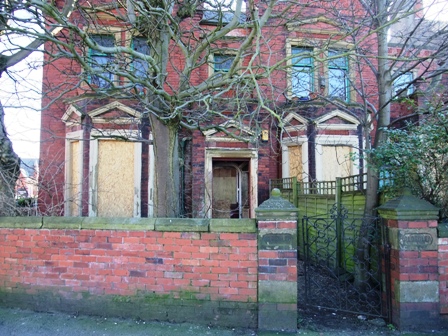
Alderlea, about to be redeveloped, March,
2010. Barlow was still playing for
Lancashire when Alderlea was under construction in 1891 but at the end of the
year he was dropped from the team. He was still coaching and umpiring and he
ran a sports outfitters at Manchester but he was living on a reduced
income.
|
Mementoes in one
shape or another of his innumerable achievements may everywhere be seen. Here is the ball with
which he wrought destruction amongst his opponents, when a youth playing with the Staveley Club.
Beside it is a similar reminiscence of an equally brilliant performance when playing with his
county in recent years. And near to them are a couple of bats bearing inscriptions, the records of
great deeds done with the willow.
Cups and other
interesting mementoes presented to him by admirers in the Antipodes occupy positions of honour
upon the sideboard, &c. From the bottom of the house to the top there is
nothing but cricket in some form or other. The very entrance gates have bats and wickets. Over
the door the same characteristic appears.
|
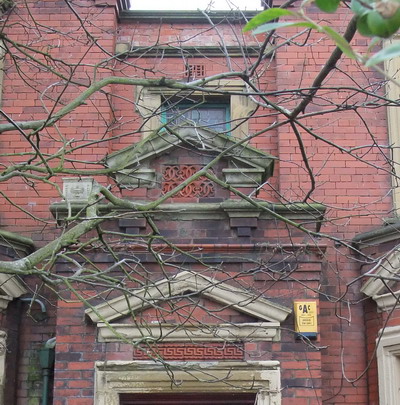
Cricket bats, balls and wickets in terra
cotta. This feature was originally placed within the pediment above the doorway to
Alderlea.
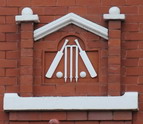
The plaque was removed and is now at Rose
Lea, in Woodland Grove.
|
|
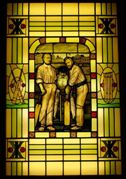
The stained glass window depicting R.G.Barlow and
A.N.Hornby which once graced the vestibule door of Alderlea. It is now at Old
Trafford. Click on the image for details.
|
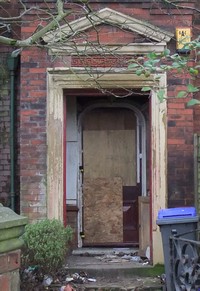 The vestibule door has stained-glass portraits of
Mr. Hornby and Barlow, bats in hand, and Pilling in a watchful attitude behind the wicket,
whilst on either side of the door are the names of well-known county players, including that
of Mr. Rowley, the captain of the county team when Barlow first joined it more than twenty-one
ago. The vestibule door has stained-glass portraits of
Mr. Hornby and Barlow, bats in hand, and Pilling in a watchful attitude behind the wicket,
whilst on either side of the door are the names of well-known county players, including that
of Mr. Rowley, the captain of the county team when Barlow first joined it more than twenty-one
ago.
Photographs of all
the principal teams which have played in this country during to past twenty years are given
prominent positions in the hall and on the walls of the dining room, and needless to say,
Barlow's likeness is in the teams representative of England, because without him they would have
been incomplete. The tiled hearth of the dining-room forms a picture of a cricket match at Lord
Sheffield's beautiful ground near Brighton, and on each side of the fire-place are tiled
portraits of Mr. Hornby, Barlow and Pilling.
Bats and stumps
appear in the oak frame of the mirror, and the window opening on to the landing of the stairs,
contains the names of the principal Lancashire cricketers since Barlow began playing with the
county, over 21 years ago. The walls of a room upstairs are covered with photographs of cricket
celebrities, including many old veterans. Clearly, Barlow's love of the game has been more than
ordinary, else he would never have been so enthusiastic in the collection and preservation of so
many curiosities. Blackpool Herald, December 2nd, 1892.
|
|
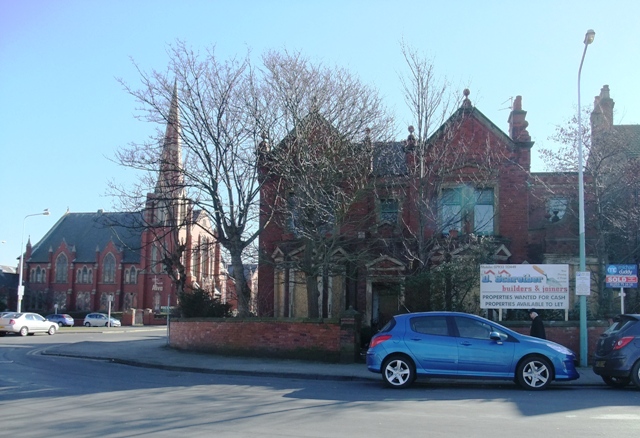
Alderlea, about to be redeveloped, March, 2010. From 1896, it
was the home and surgery of Dr Robert H W Dunderdale (1868-1940). Alexander Orr Bruce (1898-1966)
joined the practice as an assistant in the 1920s, eventually succeeding to it. He retired in 1963
and gave up his practice in 1965. About 2001, the house was partially converted into
flats, a garage inserted and a side extension added 2004; the building then fell
into disrepair.
These colour photos were taken in 2010, when Alderlea had just been purchased by
a builder. He went to great lengths to sympathetically renovate and restore the building. The
exterior in 2009 & 2018 can be viewed and compared on Google Maps:
Alderlea on Google Maps in 2009.
Alderlea on Google Maps in 2018.
|
Barlow's Second House in Blackpool.
|
Glen May Villa 1895-1913
|
|

Raikes Parade in the
early 1890s, viewed from Raikes Hall Gardens. The side of
Alderlea can be seen to the right, before Richard Barlow had Glen
May constructed. Compare this with with the photo
below.
|
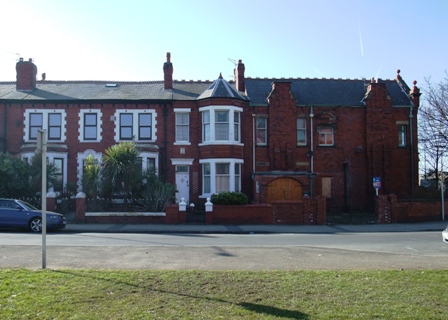 Raikes Parade in 2010. Alderlea, 8-10, Raikes Parade (right)
with Glen May Villa (no.12) and
Eaglehurst (no.14) to the left. Probably on account of his reduced income, Barlow
had Glen May Villa built in the grounds of Alderlea in 1895. He moved into this much
smaller house and sold Alderlea to a local doctor, Robert H W
Dunderdale. Raikes Parade in 2010. Alderlea, 8-10, Raikes Parade (right)
with Glen May Villa (no.12) and
Eaglehurst (no.14) to the left. Probably on account of his reduced income, Barlow
had Glen May Villa built in the grounds of Alderlea in 1895. He moved into this much
smaller house and sold Alderlea to a local doctor, Robert H W
Dunderdale.
|
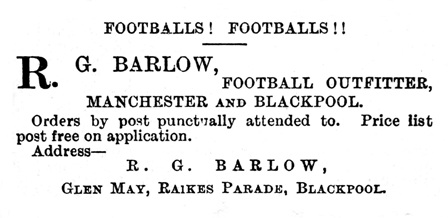
An advert for
Richard Gorton Barlow as a 'Football Outfitter', Manchester and Blackpool, October,
1896. Since 1880 he had been in business as a sports outfitter with a shop
at Victoria Station Approach,
Manchester.
|
Glen May
Villa
Blackpool Gazette
& Herald, April 29th, 1898.
|
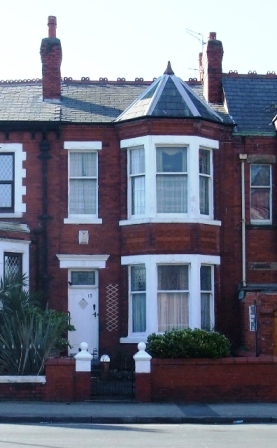
Glen May Villa, Raikes Parade,
Blackpool. He lived at Glen May between 1895 and c1913 with
his wife Harriet and daughter Elizabeth Alice; in the 1901 census his
occupation is given as "Cricket
Referee".
|
Quiet and unassuming,
Mr. Barlow is a most interesting companion, and whenever conversation drifts to his favourite
subject he loves to dwell with pardonable pride upon the many important matches in which he took
part during the many years he was prominently before the public. The other day I spent a very
pleasant hour in his company talking of cricket and cricketers, and I eventually managed, though
not without some difficulty, to elicit from him particulars of some of his best
performances.
His house, Glen
May, in Raikes Parade, where I had the pleasure of a
chat with him, is full of interesting mementoes of the cricket field. As an ardent sportsman loves
to be surrounded by trophies of the chase, so Mr. Barlow's cosy rooms abound with portraits of old
comrades and friendly rivals for whom he entertains the highest regard, of pictures of cricket
grounds whereon some of his chief triumphs were won, of treasured gifts from admirers in England
and the Colonies, and of the bats and balls with which he achieved his greatest
successes.
|
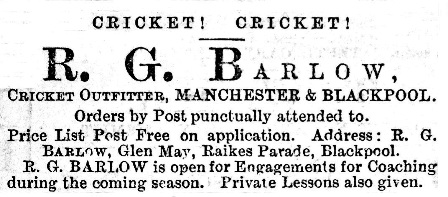
An
advert for Richard Gorton Barlow as a 'Cricket Outfitter' and coach, Manchester and
Blackpool, June, 1896. His
address was now Glen
May.
|
Blackpool Gazette & Herald, April 29th, 1898... continued....
Here, for instance, is a bat bearing distinct traces of much hard usage. It is one with which he
played In England, Ireland, Scotland, and Wales, which he regularly used during one of his tours
round the world, and with which he scored more than 4,000 runs! Truly, a record bat, and one which
neither love nor money would ever induce him to part with. There is another tried and trusty friend
with which he once compiled a record score of 101 upon a sticky and treacherous wicket at
Nottingham.
|
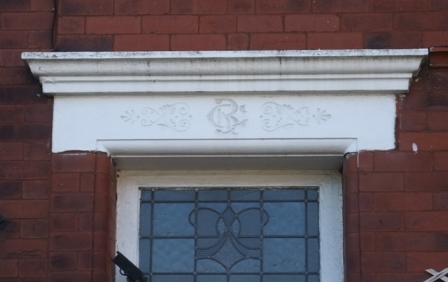
Glen May Villa, Raikes Parade,
Blackpool.The initials
R.G.B. above the door for Richard Gorton
Barlow.
|
Adjoining it is the
one presented to him on the occasion of his making 113 in an important match against the
Australians. Here, too, are a couple of bats presented to him in commemoration of early triumphs
won while still a youth when he played for Stavely, in Derbyshire, where his cricketing talents
first brought him into prominence. In another part of the house we see a neat cricketing design,
formed of bats and balls presented to the veteran stonewaller for some exceptionally clever
performances.
Wherever we turn, we find something to awaken fresh interest in the game. The
fire-place in the front room is unique. "Cricket on the Hearth" is represented by a view of Lord
Sheffield's pretty ground near Brighton, artistically painted on the tiles; while portraits of
Hornby and Barlow, and of Pilling, the famous wicket-keeper, may be seen on tiles on either side
of the grate.
Excellent pictures of the same trio are likewise reproduced in colours in the
stained glass panel of the vestibule door, and portraits of other well-known county cricketers
of the past also appear on the panels of the octagon-shaped lamp suspended from the ceiling in
the hall. Blackpool Gazette & Herald, April 29th, 1898.
|
|
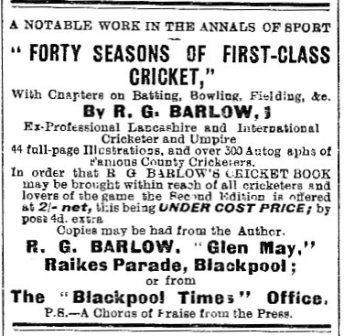

R.G.Barlow had published a book 'Batting and Bowling, with hints on Fielding and
Wicket-Keeping' in 1882. Whilst at Glen May he wrote his
autobiography: 'Forty Seasons of First-Class Cricket. Being the autobiography and
reminiscences of Richard Gorton Barlow.', published in 1908.
|
|
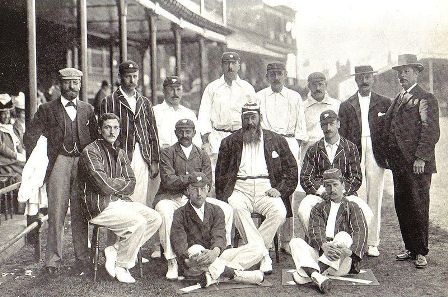
England team with Dick Barlow as umpire, Trent
Bridge 1899. Back row L-R: Dick Barlow (umpire), Tom Hayward, George Hirst, Billy
Gunn, J T Hearne (12th man), Bill Storer (wkt kpr), Bill Brockwell, V A Titchmarsh (umpire). Middle
row: C B Fry, K S Ranjitsinhji, W G Grace (captain), Stanley Jackson. Front row: Wilfred Rhodes,
Johnny Tyldesley.
|
|
|
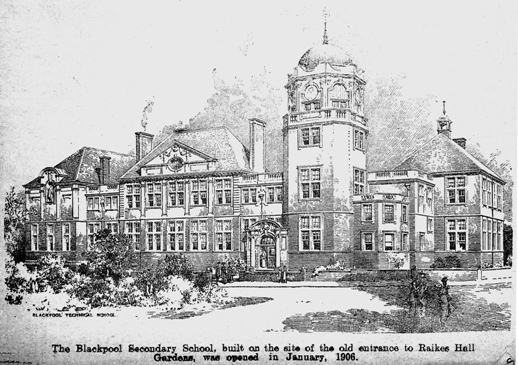
Blackpool Secondary School in the early 1900s. Later
renamed Blackpool Grammar, it was erected on the site of the old Raikes Hall Gardens
entrance gates c1905. This building is now the Salvation Army Citadel. See
below.
|
|
Some views from Glen May Villa, Raikes Parade, Blackpool,
2010. When Glen May was erected it overlooked Raikes Hall Park. Barlow would have
witnessed the construction of these streets and buildings as it became a residential area.
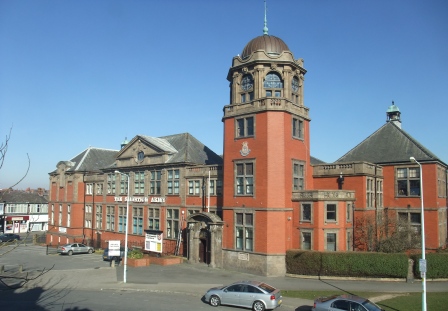
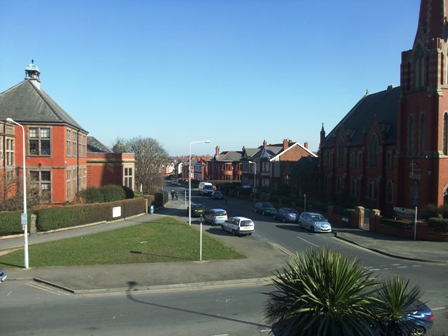
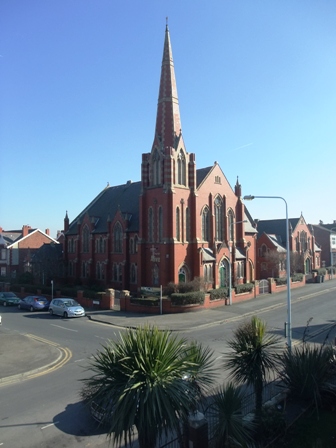
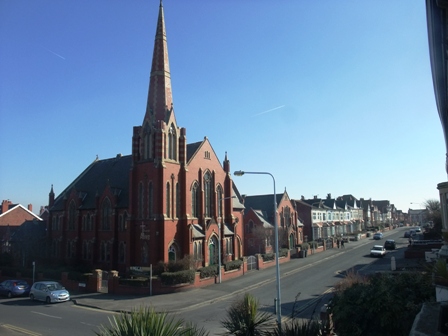
|
Rose Lea 1913-1919
|
|
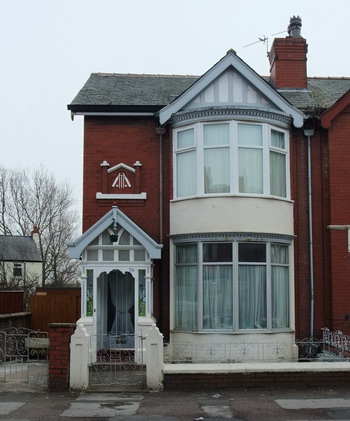 R.G.Barlow lived with his wife until her
death in 1918, but he also had a relationship with an accountant at the Imperial
Hotel, Blackpool and they had a son, Reginald Gorton Barlow Thompson
(1911-1982). R.G.Barlow lived with his wife until her
death in 1918, but he also had a relationship with an accountant at the Imperial
Hotel, Blackpool and they had a son, Reginald Gorton Barlow Thompson
(1911-1982).
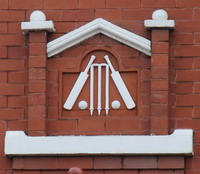
Rose Lea, Woodland Grove,
Blackpool, March, 2010. Barlow had another house erected in Woodland
Grove, near the Stanley Park cricket ground; he lived there from about 1913, until his
death in 1919.
|
|
Blackpool Herald, 2 April 1918.
Late Mrs. R. G.
Barlow.
The remains of the late Mrs. R. G. Barlow [Harriet] were laid to rest in the
Blackpool Cemetery on Saturday afternoon. In accordance with the desire of the
deceased lady, the funeral was as quiet and simple as possible.
The only floral tribute was from her husband , consisting of arum lilies and
roses arranged in the form of a cricket bat, bearing the words “ In loving
remembrance of my dear wife. R. G. Barlow, ‘Rose Lea,’ Woodland Grove,” as it had
been Mrs. Barlow’s expressed wish that no other flowers be sent.
The mourners were the widower, Mr. & Mrs. A. F. Wilson, daughter and
son-in-law, and Miss M. Barlow, sister-in-law.
The obsequies were conducted by the Rev. Chas. B. Ellis of the Whitegate drive
Baptist Church.
|
|
Blackpool Times, 2 August 1919
Death of Mr. R. G.
Barlow.
One of the most distinguished of cricketers that England ever
produced passed away on Monday morning at Blackpool, in the person of Mr. Richard
G. Barlow, at the residence of his son-in-law, Mr. Wilson, Woodland Grove,
Blackpool. “R. G.,” as he was familiarly known in cricket circles in the country,
was one of the mainstays of the Lancashire County team up to 1892, having played
with the County for 21 years. . .
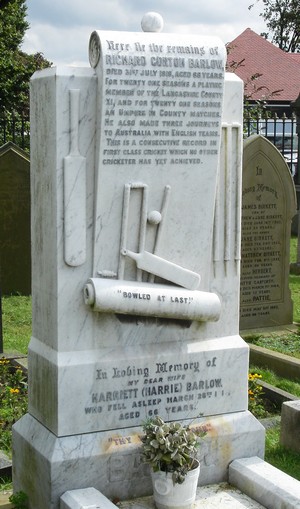 On retiring from first-class cricket, he came to reside at
Blackpool over 25 years ago, and built for himself a house at the corner of
Raikes Parade, which he subsequently sold to Dr. Dunderdale. The house was
easily identified by the cricketer’s armorial bearings over the doorway – bats
and wickets in terra-cotta. The coloured glass in the vestibule door was a
representation of Mr. A. N. Hornby (Captain of the Lancashire County team),
Mr. Barlow, and the late Richard Pilling in the act of keeping wicket. The
interior fittings of the house were all more or less symbolical of cricket. .
. . On retiring from first-class cricket, he came to reside at
Blackpool over 25 years ago, and built for himself a house at the corner of
Raikes Parade, which he subsequently sold to Dr. Dunderdale. The house was
easily identified by the cricketer’s armorial bearings over the doorway – bats
and wickets in terra-cotta. The coloured glass in the vestibule door was a
representation of Mr. A. N. Hornby (Captain of the Lancashire County team),
Mr. Barlow, and the late Richard Pilling in the act of keeping wicket. The
interior fittings of the house were all more or less symbolical of cricket. .
. .
He had been in
failing health for over twelve months – never being the same man since his wife
died, and so great was his love for the game that he continued to keep his official
umpire engagements, even against his doctor’s advice. . . .
One daughter (Mrs. Wilson), a grandson (Master Leslie
Wilson), two sisters (Mrs. [Harriet Emma] Pye and Miss Barlow, [17] Forest Gate),
and a nephew (Mr. J. J. Barlow [88 Manchester Road in 1923]), all living in
Blackpool, survive him. . . .
There is already a tombstone at the Blackpool Cemetery
where his wife is interred, and the stone is engraved in anticipation of his own
death with the words, “bowled out,” the date being left blank, but which will now
be filled in “July 31st.”
|
|
|